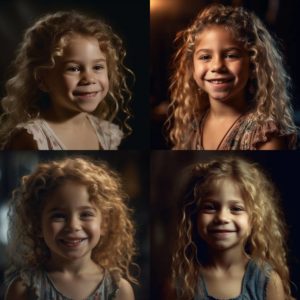AI-Powered Art Tutorial: Transform Famous Musicians into Kids with Midjourney
AI-Powered Art Tutorial: Transform Famous Musicians into Kids with Midjourney
Discover how to recreate your favorite musicians as children using the AI-powered tool Midjourney, which generates images from simple text inputs.
Taylor Swift, Ed Sheeran and Shakira.
💬 [Musician] [age], [Type of shot], [Shot details], studio photography, volumetric lighting, [clothing], [facial expression], [trait], realistic, [Focal Length], expressive, iconic, 4k --ar 2:3
In this mini-tutorial, we’ll focus on transforming famous musicians into their younger selves. Using Midjourney, an AI-powered image generation tool, you can create images of anyone as a child simply by adjusting the text inputs.

💬 Taylor Swift as a kid, portrait, close-up shot, studio photography, volumetric lighting, wearing a dress, smiling, cheerful, realistic, 50mm, expressive, iconic, 4k
In this example, we aim to transform Taylor Swift into a child. You can further customize the image by specifying the outfit colors and background. For simplicity, we’ll let the AI decide those aspects for us.
To generate new versions of the image, press the 🔁 button in Midjourney until you’re satisfied with the result. Let’s try with Ed Sheeran, and notice how the AI offers four different versions (you can re-roll for more options). Select the images that closely resemble the real person and upscale them for better quality.

💬 Ed Sheeran as a kid, portrait, close-up shot, studio photography, volumetric lighting, wearing a t-shirt, smiling, friendly, realistic, 50mm, expressive, iconic, 4k --ar 2:3
And finally Shakira.

💬 Shakira as a kid, portrait, close-up shot, studio photography, volumetric lighting, wearing a dress, smiling, cheerful, realistic, 50mm, expressive, iconic, 4k --v 5 --s 750
The AI does an impressive job of retaining well-known traits while imagining what the person might have looked like as a child, or exaggerating childlike features. Let’s upscale the first photo.
You can modify the base prompt to transform any known figure into a child. Have fun experimenting with different musicians, adjusting their outfits, and seeing the AI’s imaginative creations.
Basic tutorial for using ChatGPT API
To use ChatGPT, you can input a natural language question or prompt and the model will generate a response. The input can be in the form of text, and the output will also be in text format.
You can use ChatGPT in various ways, including:
- Interfacing with an API: You can use the OpenAI API to integrate ChatGPT into your own applications or services.
- Using the OpenAI Playground: The OpenAI Playground allows you to test ChatGPT and other OpenAI models in a web-based interface.
- Implementing it on your own: You can also build your own implementation of ChatGPT using the OpenAI GPT-3 model.
Note: Access to the full version of ChatGPT may be limited and requires an API key from OpenAI.
Here is a basic tutorial for using ChatGPT, a large language model developed by OpenAI API:
- Go to the OpenAI website (https://openai.com/) and create an account.
- Once you have an account, you can access the OpenAI API and use it to interact with ChatGPT.
- You can use the API in different ways, one of them is to use it in a Jupyter notebook or in a python script. To do this, you will need to install the openai library. You can install it by running:
!pip install openai
Once you have the library installed, you can use the OpenAI API key to interact with ChatGPT. You can do this by setting the API key as an environment variable:
import openai_secret_manager
assert "openai" in openai_secret_manager.get_services()
secrets = openai_secret_manager.get_secrets("openai")
print(secrets)
To use ChatGPT, you can use the openai.Completion.create() function, which takes several parameters, such as the prompt (the text you want to generate a response for), the model (ChatGPT), and the API key.
Here is an example of how to use the openai.Completion.create() function to generate a response from ChatGPT:
import openai openai.api_key = secrets["api_key"] prompt = "What is the capital of France?" completions = openai.Completion.create( engine="text-davinci-002", prompt=prompt, max_tokens=1024, n=1, stop=None, temperature=0.5, ) message = completions.choices[0].text print(message)
This is a basic example of how to use ChatGPT, but you can also customize the model and the parameters to fit your needs. You can also use it in different ways, like creating a chatbot, a language translator and many other ways.
Please note that the key and the model may have been updated, but the process is similar.


